Skin Deep: The Tale of India’s Tattoo Tradition
Trace the 5000-year-old history of tattoos in India from its humble beginnings to its role in mainstream fashion.

From being used as a sign of status to jewellery-like markings, tattoos have been around in India since ancient times. But just how old this custom is, remains a mystery. From the dense, rain-soaked mountain jungles of the northeast to the dry deserts of Rann of Kutch in the far west, tattoos have not always been about beautifying the human body; they have been used for diverse reasons by different communities across the country.

Photo Source
For hundreds of years, the tradition of tattooing was venerated across the agrarian and forested landscapes of India. The ancient maze-like carvings on prehistoric rocks were copied by tribal communities on their bodies. They called the process gudna (burying the needle in Hindi)and flaunted the markings as jewellery – the kind of jewellery no one could take away from them even if they were to lose all their worldly possessions.
Most of India’s tattooed tribes lived in the remote hinterlands of the country, where stealing of women by rival tribes was a common occurrence.
In the Apatani tribe of Arunachal Pradesh, for instance, young girls were tattooed to make them unappealing to the rival tribes of the neighbouring districts, who could otherwise abduct their prettiest women.
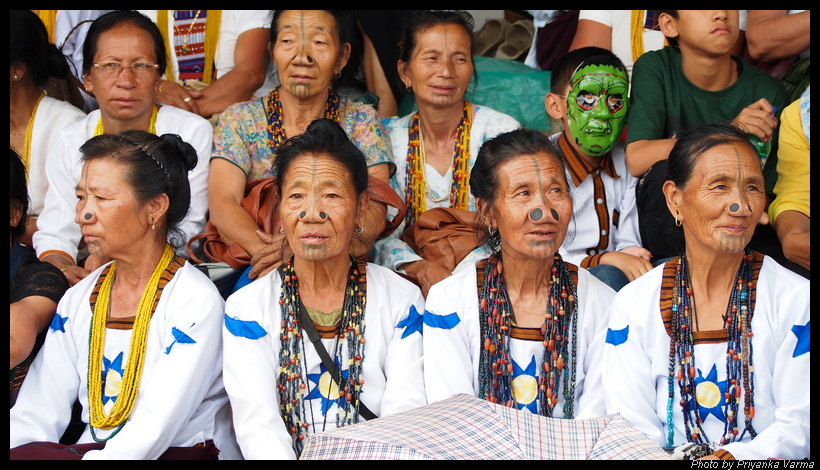
Photo Source
The Apatani tattooing procedure involved using thorns to cut the skin and soot mixed in animal fat to fill in the deep blue colour. The wounds were then allowed to get infected so that the tattoos became larger, darker and clearer. The Indian government put a ban on this in the 1970s but the practice lives on in some of the untouched interiors of the northeast.
Another tribe, the Singhpo of Assam and Arunachal, had distinct rules for each gender. The married women were tattooed on both legs from the ankles to the knees, while the men tattooed their hands. The unmarried Singpho girls were barred from wearing tattoos.
Also prominent among the tattooed tribes of the northeast were the headhunting Konyaks of Nagaland who tattooed their faces to indicate their prowess in battle and headcount. Tattoos also helped in establishing tribal identity in the region, besides enabling recognition after death in a war or fatal accident.
Body art was very prevalent among the warlike tribes of the northeast (including the Noctes and Wanchos of Arunachal) as they regarded tattoos as a sign of strength, courage, and virility because of the pain associated with the piercing process.
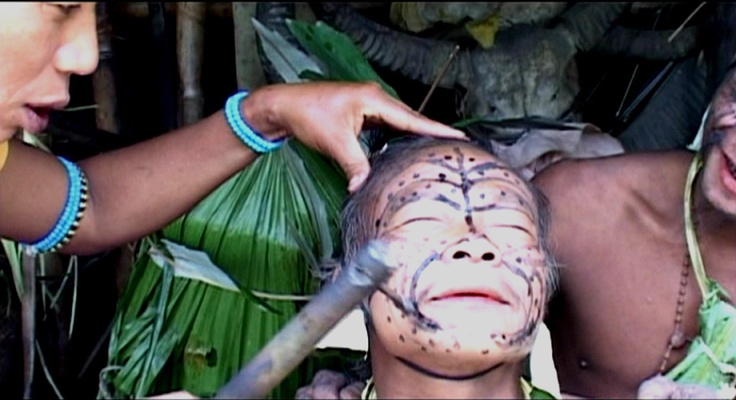
Photo Source
In Southern India, permanent tattoos are called pachakutharathu. They were very common, especially Tamil Nadu, before 1980. The nomadic Korathi tattoo artists travelled the countryside in search of clients. The kollam, a sinuous labyrinthine design believed to ensnare evil beings, is inked on bodies to permanently keep them safe and secure until reunited with deceased ancestors in the afterlife.
Among the Toda tribe of South India, the hands and calves and shins are tattooed with the same geometric patterns used in their embroidery.

Photo Source
Central India also has a long and barbaric tradition of tattooing. The Dhanuks in Bihar believe tattoos deglamourize women – this helps them evade the eyes of influential sex predators. Due to the prevalence of purdah, women from lower castes had to have visible parts of their bodies tattooed to signal their inferior status.
On the other hand, the Munda tribe in Jharkhand, which values courage, uses body art to record historic events. The Mundas thrice defeated the Mughals and, to commemorate these victories, Munda men even today tattoo three straight vertical lines on their foreheads.
The Gonds of Central India, one of India’s largest tribes, traditionally left much of their bodies exposed. The bare skin was covered with kohkana (Gondi for tattoos) to ensure they looked decent.
Women of the Kutia Kondh tribe of Orissa, called the ‘the people of the spirit world,’ ink themselves with beautiful geometric facial tattoos; it is said these identifying marks ensure they recognize each other once they enter the spirit world.

Photo Source
The Santhal tribes of Bengal and Jharkhand have different tattoos for each sex, for different parts of the body and for different life stages. The men inscribe tattoos called sikkas on their forearms and wrists, named thus because they are usually the size of coins called sikka in the Santhal dialect. The number of these tattoos is always odd, because odd numbers signify life and even numbers symbolise death in Santhal cosmology.
Floral patterns are painstakingly inked on the bodies of Santhal women, including their faces. It is believed the painful experience prepares a girl for motherhood and gives her the strength to face the challenges of life. The chati godai, for instance, is a tattoo inscribed on a girl’s chest when she attains puberty and, if not then, when she gets married. On completion, the tattoo is washed with soap-nut water to cool it and decrease the pain.
Even among the tribes of western India, the craft of tattooing is revered, with tattoos having a close relation to secular and religious subjects of devotion. The Rabari women of Kutch have practised tattooing for decorative, religious, and therapeutic purposes for hundreds of years. A traditional Rabari tattoo kit is simple: a single needle and gourd bowl to hold the liquid pigment, which is made by mixing lamp soot with tannin from the bark of local trees. A small quantity of turmeric powder is also added to brighten the colour and to prevent swelling.
The Rabari women tattoo elaborate symbols onto their necks, breasts and arms, signifying their strong faith in magic.
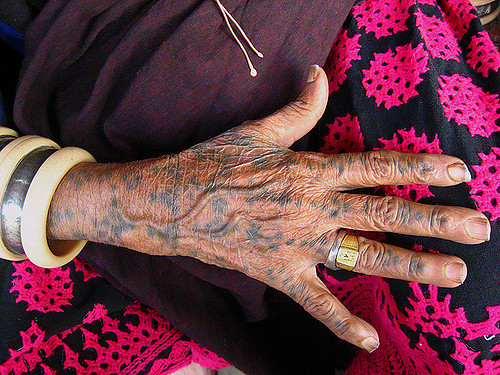
Photo Source
The Kothari women generally begin the task of elaborate tattooing by bestowing blessings on their subjects while the Rajput women bear the emblem of Krishna’s crown on their arms as a mark of aristocracy. Despite the wails of pain, the ladies are always perfect in their designing of the symbols and figures. Tattoos are also used to strengthen the marital relationship between couples, with the symbol of Moon protecting his favourite wife and Lord Vishnu’s tools like wheel and lotus being marked on the wife’s palms to keep her secure.
The tattoo motifs preferred by the Mer tribe of Gujarat also include holy men, popular gods and symbols derived from nature. A Mer woman’s most favourite tattoo design is called hansali, which extends right from her neck to the border of her inner feet.
The temporary tattoo art of mehndi also has a deep rooted cultural connect with India, with the use of mehndi and turmeric being described in the earliest Vedic ritual books.
The primary focus of mehndi in India has always been on the women of the house and it is traditionally used for celebrations and rites of passage.
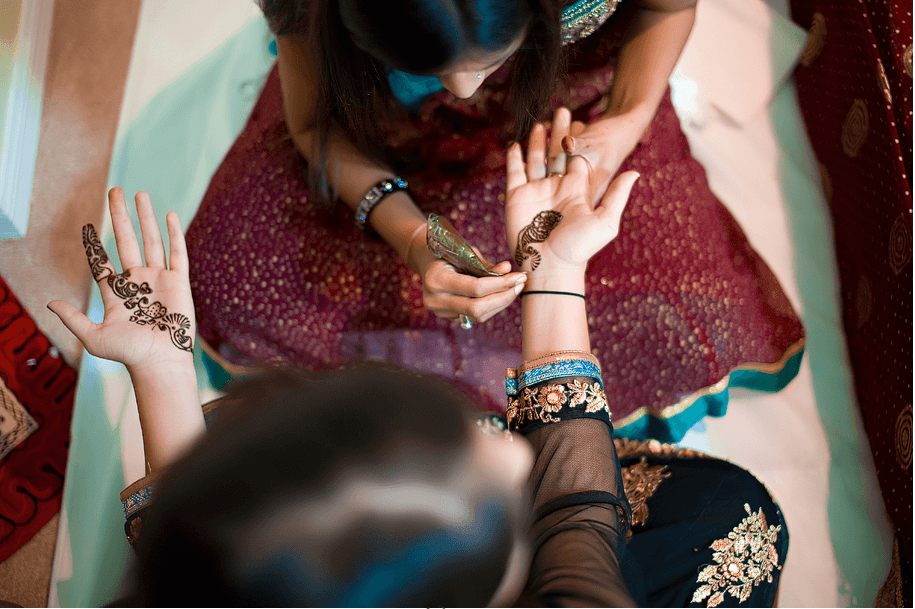
Photo Source
In recent history, Chhattisgarh’s Ramnamis fought caste discrimination with full-bodied ‘Ram Ram‘ tattoos, a message to their persecutors that God is everywhere, regardless of a person’s caste or social standing.
Denied entry to temples and forced to use separate wells, the Ramnamis first tattooed their bodies and faces more than 100 years ago with these words, which are as much a demonstration of devotion as a talisman against persecution.

Photo Source
While body art has been practised for centuries in many Indian communities, it’s only over the past few decades that tattoos have become a fashion statement among urban Indian youth. Tribal adaptation of popular designs like the dragon and tiger and abstract art are gaining popularity among the youth. Memorial tattoos, which commemorate the death of a dear one or a much-loved pet, spiritual tattoos, and tattoos with the name of the significant other, are hugely popular too.
In 2015, three Indians – Nagaland’s Mo Naga, Kolkata’s Abhinandan “Obi” Basu and Delhi’s Manjeet Singh – were featured in the World Atlas of Tattoo, a list of 100 notable tattoo artists from around the globe published by Yale University Press.
An award winning tattoo artist, Manjeet Singh’s speciality are his incredibly photorealistic designs. He loves doing tattoos inspired by the Sikh religion and is an internationally acclaimed portrait tattoo artist.

Photo Source
Abhinandan Basu, whose tattoos are rooted in Bengali folk art, is known for his special customised body art, which is called ‘Bongo’ – inspired by the Bengali folk art form ‘Patachitra’ (scroll painting) and the works of legends like Jamini Roy.
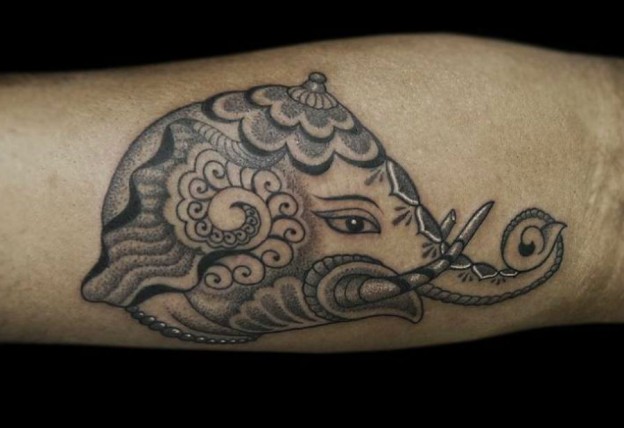
Photo Source
Nagaland’s Mo Naga wants to create modern patterns emerging out of the traditional designs and has founded the Headhunters’ Ink Tattoo School at Guwahati. He is using modern machines and techniques of tattooing to revive the traditional designs of the tribes of the northeast.
“I am not trying to bring back the old beliefs and lifestyle. My effort is to tell the stories of our forefathers through art and design,” says Mo Naga, who believes that a thorough study of the traditional tattoo patterns can reveal priceless pieces of history.
An alumnus of NIFT-Hyderabad, Mo Naga is a self-taught tattoo artist who takes his inspiration from Naga culture, as reflected in tribal costumes, folk tales, paintings, wood carvings, etc.
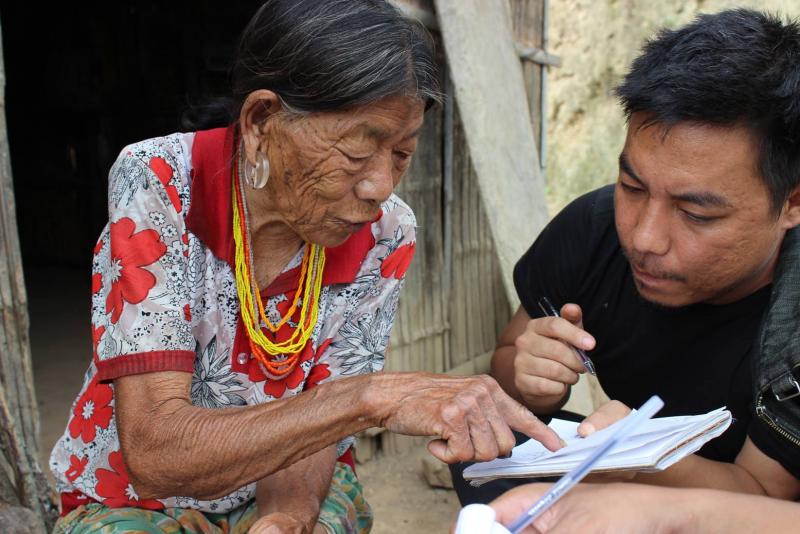
Photo Source
Over the ages, Indian body art has undergone a great transformation – from tattooing for beauty and tradition to tattooing for fashion and beliefs. A blend of creativity and fashion, tattoos are no longer just about identity and territory. In today’s world, they have become a way to express beliefs, memories and the phase one is going through in life.
Like this story? Or have something to share? Write to us: [email protected], or connect with us on Facebook and Twitter (@thebetterindia).
This story made me
-
97
-
121
-
89
-
167
Tell Us More
We bring stories straight from the heart of India, to inspire millions and create a wave of impact. Our positive movement is growing bigger everyday, and we would love for you to join it.
Please contribute whatever you can, every little penny helps our team in bringing you more stories that support dreams and spread hope.



















